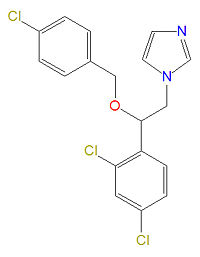Econazole: Difference between revisions
imported>David E. Volk No edit summary |
mNo edit summary |
||
| (3 intermediate revisions by 2 users not shown) | |||
| Line 15: | Line 15: | ||
}} | }} | ||
::''see also [[ | ::''see also [[Catalog_of_azole-based_antifungal_drugs]]'' | ||
'''Econazole''' is a broad-spectrum [[azole]]-based [[antifungal drug]] with limited activity against [[Gram-positive bacteria]]. It is administered topically, orally and intravenously. It is similar to the related azole-based drugs [[fluconazole]], [[clotrimazole]], [[ketoconazole]] and [[intraconazole]], among others. It is used for topical treatment of tinea species, including [[tinea pedis]], [[tineas cruris]], [[tinea versicolor]] and [[tinea corporis]], the Trichophyton species [[Trichophyton rubrum]], [[Trichophyton mentagrophytes]], and [[Trichophyton tonsurans]]. Addition infections treatable with econazole include the Microsporum species [[Microsporum canis]], [[Microsporum audouini]],and [[Microsporum gypseum]], and [[Epidermophyton floccosum]] and cutaneous [[candidiasis]]. | '''Econazole''' is a broad-spectrum [[azole]]-based [[antifungal drug]] with limited activity against [[Gram-positive bacteria]]. It is administered topically, orally and intravenously. It is similar to the related azole-based drugs [[fluconazole]], [[clotrimazole]], [[ketoconazole]] and [[intraconazole]], among others. It is used for topical treatment of tinea species, including [[tinea pedis]], [[tineas cruris]], [[tinea versicolor]] and [[tinea corporis]], the Trichophyton species [[Trichophyton rubrum]], [[Trichophyton mentagrophytes]], and [[Trichophyton tonsurans]]. Addition infections treatable with econazole include the Microsporum species [[Microsporum canis]], [[Microsporum audouini]],and [[Microsporum gypseum]], and [[Epidermophyton floccosum]] and cutaneous [[candidiasis]]. | ||
== Mechanism of action == | == Mechanism of action == | ||
Like other azole-based antifungal agents, econazole increases cell permeability by interacting with 14-α demethylase, a cytochrome P-450 enzyme necessary in the conversion of [[lanosterol]] to [[ergosterol]], a necessary component of cell membranes. "Econazole may also inhibit endogenous respiration, interact with membrane phospholipids, inhibit the transformation of yeasts to mycelial forms, inhibit purine uptake, and impair triglyceride and/or phospholipid biosynthesis."<ref>{{ | Like other azole-based antifungal agents, econazole increases cell permeability by interacting with 14-α demethylase, a cytochrome P-450 enzyme necessary in the conversion of [[lanosterol]] to [[ergosterol]], a necessary component of cell membranes. "Econazole may also inhibit endogenous respiration, interact with membrane phospholipids, inhibit the transformation of yeasts to mycelial forms, inhibit purine uptake, and impair triglyceride and/or phospholipid biosynthesis."<ref>{{CZMed}} | ||
</ref> | |||
== Brand names == | == Brand names == | ||
| Line 34: | Line 35: | ||
* Spectazole® | * Spectazole® | ||
* Spectazole cream® | * Spectazole cream® | ||
== References - external links == | == References - external links == | ||
{{CZMed}} | |||
* <references/>[[Category:Suggestion Bot Tag]] | |||
* <references/> | |||
Latest revision as of 06:00, 10 August 2024
|
| |||||||
| econazole | |||||||
| |||||||
| Uses: | antifungal drug | ||||||
| Properties: | azole compound | ||||||
| Hazards: | see drug interactions | ||||||
| |||||||
Econazole is a broad-spectrum azole-based antifungal drug with limited activity against Gram-positive bacteria. It is administered topically, orally and intravenously. It is similar to the related azole-based drugs fluconazole, clotrimazole, ketoconazole and intraconazole, among others. It is used for topical treatment of tinea species, including tinea pedis, tineas cruris, tinea versicolor and tinea corporis, the Trichophyton species Trichophyton rubrum, Trichophyton mentagrophytes, and Trichophyton tonsurans. Addition infections treatable with econazole include the Microsporum species Microsporum canis, Microsporum audouini,and Microsporum gypseum, and Epidermophyton floccosum and cutaneous candidiasis.
Mechanism of action
Like other azole-based antifungal agents, econazole increases cell permeability by interacting with 14-α demethylase, a cytochrome P-450 enzyme necessary in the conversion of lanosterol to ergosterol, a necessary component of cell membranes. "Econazole may also inhibit endogenous respiration, interact with membrane phospholipids, inhibit the transformation of yeasts to mycelial forms, inhibit purine uptake, and impair triglyceride and/or phospholipid biosynthesis."[1]
Brand names
- Econazole Nitrate®
- Ecostatin®
- Ecostatin Vaginal Ovules®
- Ecostatin cream®
- Gyno-Pevaryl®
- Gyno-Pevaryl 150®
- Ifenec®
- Palavale®
- Pevaryl®
- Spectazole®
- Spectazole cream®
References - external links
The most up-to-date information about Econazole and other drugs can be found at the following sites.
- Econazole - FDA approved drug information (drug label) from DailyMed (U.S. National Library of Medicine).
- Econazole - Drug information for consumers from MedlinePlus (U.S. National Library of Medicine).
- Econazole - Detailed information from DrugBank.
- Econazole - FDA approved drug information (drug label) from DailyMed (U.S. National Library of Medicine).
- Econazole - Drug information for consumers from MedlinePlus (U.S. National Library of Medicine).
- Econazole - Detailed information from DrugBank.
